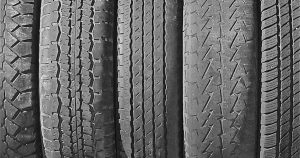 When you’re behind the wheel of your Toyota, there are a number of systems and components at work that keep you safe while on the road. One of the most important safety systems is something you might not expect: your tires. Without proper tread, your tires can quickly become a hazard on the road. Watch for these signs that you need new tires and get them replaced frequently to ensure your safety.
When you’re behind the wheel of your Toyota, there are a number of systems and components at work that keep you safe while on the road. One of the most important safety systems is something you might not expect: your tires. Without proper tread, your tires can quickly become a hazard on the road. Watch for these signs that you need new tires and get them replaced frequently to ensure your safety.
1. Low Tread
One easy way to tell if you need new tires is to check the tread levels. When the tread wears down, which happens naturally as you drive, the tires are no longer able to grip the road and could slide or skid when you apply the brakes. This becomes even more dangerous when road conditions are less than optimal.
Check the tread by sticking a penny, upside-down, into the grooves of one of the tires. If any part of Abraham Lincoln’s head is covered, your tires still have the legally required amount of tread to keep driving on them. If not, it’s time for a new set of tires.
2. Skidding When You Brake
Another major indicator that your tires are wearing out is if you feel the car skidding or sliding when you hit the brakes. Your tires work in conjunction with the braking system, allowing your car to stop. If the tires aren’t able to properly grip the asphalt, you won’t be able to stop quickly. Snowy, icy, or wet roads will further magnify the issue. You might notice your steering wheel vibrates when you apply the brakes as well. This could mean you need a new set of brake pads, but it can also be the result of worn out or poorly installed tires.
3. Cracks or Bulges
About once a week, walk around your car and visually assess your tires. When a tire starts to deflate, it will bulge out on the sides, so look for areas that are bulging or cracking. If you notice any of these signs, you could have a slow leak that you’ll need to fix. Ignoring a problem like this could lead to a more serious issue, such as getting a flat tire at an inopportune time or even experiencing a blowout when you’re driving at a high speed.
4. Changes in Pressure
There are certain things that affect the pressure in your tires, such as changes in temperature. It’s important to make sure the tires are at the correct pressure before you head out on the road. If you drive on tires that are too low, you run the risk of damaging the wheels, while driving on overinflated tires can result in a blowout or other damage to the tire. Make sure you have a tire pressure gauge in your glove box and check the tires every time you get gas. This is helpful because if your tires are low, it’s easy to fill them up while you’re there.
Keeping your tires in good condition is an important part of maintenance for your Toyota and helps protect you and your passengers.
Image via Flickr by Dean Hochman



![[Facebook]](https://www.scottclarkstoyota.com/blogs/207/wp-content/plugins/bookmarkify/facebook.png)
![[LinkedIn]](https://www.scottclarkstoyota.com/blogs/207/wp-content/plugins/bookmarkify/linkedin.png)
![[Twitter]](https://www.scottclarkstoyota.com/blogs/207/wp-content/plugins/bookmarkify/twitter.png)
![[Yahoo!]](https://www.scottclarkstoyota.com/blogs/207/wp-content/plugins/bookmarkify/yahoo.png)
![[Email]](https://www.scottclarkstoyota.com/blogs/207/wp-content/plugins/bookmarkify/email.png)


